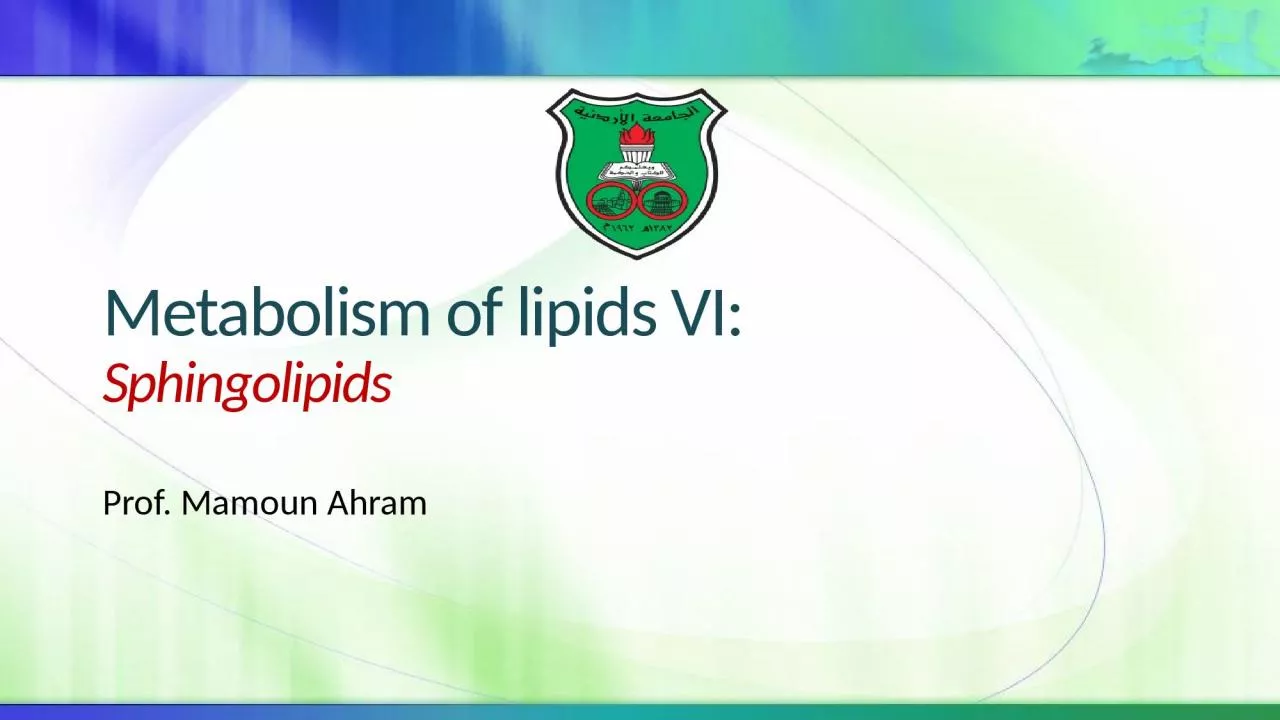

Sphingolipids Prof Mamoun Ahram Resources This lecture Lippincotts Biochemistry Ch 17 Structure of sphingolipids Synthesis of sphingomyelin Palmitoyl CoA condenses with serine releasing CoA and CO2 ID: 915934
Download Presentation The PPT/PDF document "Metabolism of lipids VI:" is the property of its rightful owner. Permission is granted to download and print the materials on this web site for personal, non-commercial use only, and to display it on your personal computer provided you do not modify the materials and that you retain all copyright notices contained in the materials. By downloading content from our website, you accept the terms of this agreement.
Slide1
Metabolism of lipids VI:Sphingolipids
Prof. Mamoun Ahram
Slide2Resources
This lecture
Lippincott’s Biochemistry, Ch. 17
Slide3Slide4Structure of sphingolipids
Slide5Synthesis of sphingomyelin
Palmitoyl CoA condenses with serine releasing CoA and CO2.
The reaction requires pyridoxal phosphate.
The product (
not shown
) is reduced in a NADPH-dependent reaction to
sphinganine
, which is acylated at the amino group with a LCFA and then desaturated to produce a ceramide.
Phosphorylcholine from phosphatidylcholine is transferred to the ceramide, producing sphingomyelin and DAG.
Slide6Deficiency of sphingomyelinase
Slide7Glycosphingolipids (glycolipids)
They are made of ceramide (precursor)
They are located in the outer leaflet of the plasma membrane (adhesion, recognition, and signaling)
A sugar(s) is attached to ceramide by an O-glycosidic bond.
The number and type of carbohydrate moieties present determine the type of glycosphingolipid.
Slide8Types of glycolipids
Neutral glycosphingolipids
Cerebrosides are the simplest.
Acidic glycosphingolipids
They are negatively charged at physiologic pH due to attachment of
N-acetylneuraminic acid ([NANA], a sialic
acid, in gangliosides or by sulfate groups in sulfatides.
Globosides
(ceramide oligosaccharides)
Lactosylceramide
Slide9More on gangliosides and sulfatides
Gangliosides
They are designated as G (for ganglioside) plus a subscript (M, D, T, or Q) to indicate number of sialic acid molecules: 1 (mono), 2 (di), 3 (tri), or 4 (
quatro
), and then numbers to indicate
indirectly
the number of sugar residues subtracted from 5:
GM1 contains 5–1 = 4 sugar residues
GD3 contains 5–3 = 2 sugar residuesSulfatides
Slide10An example
Slide11Synthesis of glycosphingolipids I
Synthesis of glycosphingolipids occurs primarily in the Golgi apparatus by sequential addition of glycosyl monomers transferred from UDP-sugars to the acceptor molecule by glycosyltransferases.
A sulfate group from the sulfate carrier 3ʹ-phosphoadenosine-5ʹ-
phosphosulfate
([PAPS], is added by a sulfotransferase to the 3ʹ-hydroxyl group of the galactose in a
galactocerebroside
, forming the sulfatide
galactocerebroside
3-sulfate.
PAPS
Slide12Synthesis of glycosphingolipids II
Slide13Glycosphingolipid degradation
Glycosphingolipids are internalized by phagocytosis into lysosomes that fuse with the phagosomes.
The lysosomal enzymes hydrolytically and irreversibly remove the sugars sequentially starting with the last one added and ending with the first one added.
Defect in the degradation of glycosphingolipid, as well as glycosaminoglycans and glycoproteins, causes “lysosomal storage diseases”.
Sphingolipidoses: disorders related to defective degradation of sphingolipids
Slide14Cer
Glc
Gal
Gal
Gal
NAcGal
NAcGal
NANA
NANA
NANA
Cer
Glc
Cer
Glc
Gal
Cer
Glc
Gal
β
Galactosidase
β
Hexoseaminidase
Neuraminidase
Slide15Sphingolipidoses
The rate of biosynthesis of the accumulating lipid is normal
usually, only a single sphingolipid (the substrate for the deficient enzyme accumulates in the involved organs.
The disorders are progressive and can be fatal.
There is extensive phenotypic variability due to
The defective gene that causes the disorder (the clinical type)
Locus heterogeneity: the type of mutation within the gene that produces the defective enzyme.
They are autosomal-recessive disorders, except for Fabry disease, which is X linked.
The incidence of the sphingolipidoses is low in most populations, except for Gaucher and Tay-Sachs diseases, which, like Niemann-Pick disease, show a high frequency in the Ashkenazi Jewish population
Slide16Slide17Tay-Sachs disase
Slide18Gaucher disease
Slide19Farber disease
Slide20Diagnosis and treatment
Diagnosis:
Measure enzyme activity in cultured fibroblasts or peripheral leukocytes
Analyzing DNA
Treatment:
Recombinant human enzyme replacement therapy
Gaucher disease and Fabry disease (expensive)
Bone marrow transplantation:
Gaucher diseaseSubstrate reduction therapyGaucher disease: Pharmacologic reduction of glucosylceramide